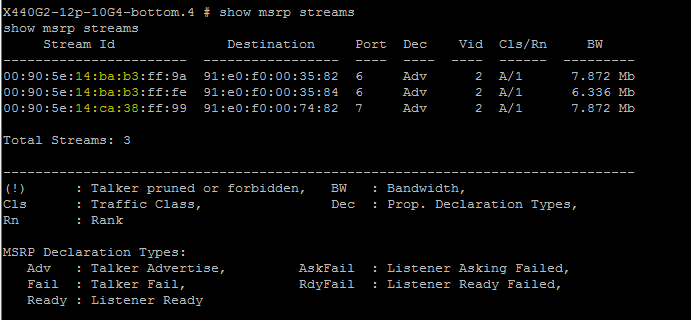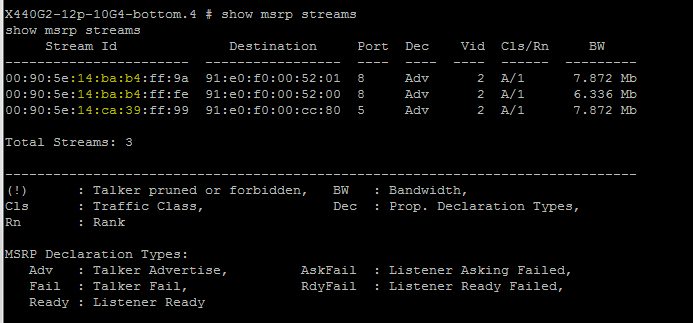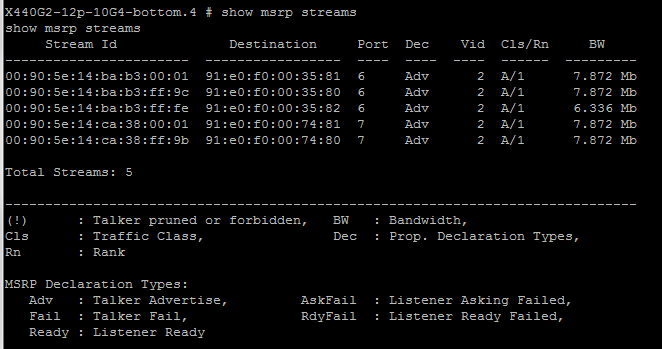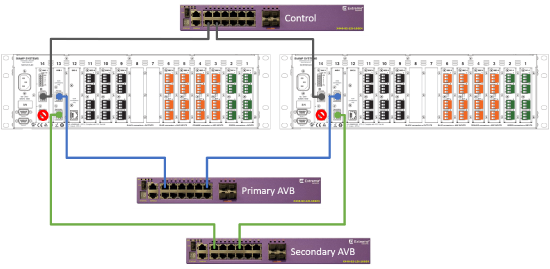AVB Primary and Secondary connections
This article describes behavior when using Tesira's primary and secondary AVB ports on parallel networks for audio path redundancy. Note this is not describing Tesira's redundant Server mode.
AVB secondary ports are only present on Tesira Server, Server-IO, and certain Tesira Amplifier models.
TesiraFORTE, TesiraLUX, and Tesira Expander-class devices only have a primary AVB port and so are only able to share streams seen on the primary AVB port of Server and Server-IO. They cannot participate in the AVB secondary network.
All AVB streams are automatically mirrored to the AVB secondary and will be used if the streams on the AVB primary are unavailable. Secondary streams are always active behind the scenes and are simply routed internally if any primary streams are lost. The pilot stream is present in both primary and secondary networks.
Streams cannot be routed from the primary to the secondary port, or vice versa. Talkers on the primary cannot connect with listeners on the secondary, or vice versa.
If all streams are present the system status will be normal, no faults or errors will be displayed by Tesira. Streams may be arriving exclusively on the primary network, exclusively on the secondary network, or a combination of the two. e.g. - If AVB streams have been lost on the primary connection but are still present over the secondary connection the system status will be normal, no faults or errors will be displayed.
Biamp's internally generated AVB streams are referred to as implicit AVB streams. Implicit streams link AVB hardware devices and are denoted by dashed blue lines in a Tesira configuration file. Streams created for communication with 3rd party AVB devices or between unique Tesira installations are referred to as explicit AVB or AVB.1 streams. AVB.1 streams require the AVB.1 input and AVB.1 output blocks in a Tesira file.
AVB.1 audio streams are only available on the primary AVB ports. AVB.1 stream AVDECC info is advertised on both networks and is routable using an AVDECC controller placed on either network. If the primary and secondary networks are bridged then the AVDECC info will be seen to be advertised twice.
Missing AVB.1 streams will not cause faults or errors to be displayed in Tesira.
Sample AVB setup - implicit only
Stream examples are shown on an Extreme Networks Summit X440.
AVB Primary only
AVB streams are identified by an 8 octet Stream ID in hex notation. The Stream ID is composed of the 6 octet (48 bit) AVB port MAC address followed by 2 octets (16 bits) indicating the unique stream identifier number. e.g. - 00:90:5e:14:ba:b3:ff:fe
The pilot stream ID ends in :ff:fe which equals decimal 65534.
In the example file there are also 2 AVB audio streams present, one in each direction. Their Stream IDs are ff:99 (65433) and ff:9a (65434)
In this example the AVB primary are connected on switch ports 6 and 7.

AVB Secondary only
Contains pilot and implicit AVB streams. The secondary pilot stream is always sent by the same device as on the primary network.
The secondary stream identifier numbers (16 bits) are the same as those seen in the primary, the AVB port MAC identifier (48 bits) is different. This ensures the 2 Stream IDs are unique.
In this example the AVB secondary are connected on switch ports 5 and 8.

What if AVB Primary and Secondary are connected to the same network?
- Will AVB "break" if the primary and secondary networks are linked? (No. The streams can co-exist on a common network.)
- How can we diagnose if networks are linked? (You will see that the expected stream count has doubled, AVB traffic has doubled, and Stream IDs will indicate both the primary and secondary streams are present.)
Streams from the primary and secondary AVB ports have unique Stream IDs due to the composite of the AVB port's MAC address plus stream ID. Each network port has a unique MAC address.
If both the Primary and Secondary AVB ports are connected to a common network the system will behave properly, however the failover benefits of a secondary network will not be realized.
Putting both Primary and Secondary on the same switch network provides wire backup only. Please don't do it this way. In the event of a switch failure all AVB is lost. Parallel switch networks should be used.
In this example the AVB primary are connected on switch ports 6 and 7 and the AVB secondary are connected on switch ports 5 and 8. The mirrored pilot streams from Unit 1 are highlighted (port 6 primary, port 8 secondary).
Sample AVB setup - implicit and explicit
Note in this example that the previous file was recompiled and the implicit AVB streams were given new Stream IDs. The have moved from ff:99 (65433) and ff:9a (65434) to ff:9b (65435) and ff:9c (65436).
The pilot streams will always be at ff:fe (65534).
AVB.1 streams (aka explicit AVB streams) are numbered sequentially beginning with 1, shown in hex notation as 00:01, in each AVB.1 talker. AVB.1 streams are not given new Stream IDs after a recompilation.
By default, AVB.1 streams are only present on the AVB primary network.
AVB Primary only
Contains pilot, implicit, and explicit AVB streams.
One explicit AVB.1 stream is being sent from each device. AVB.1 audio streams are only present on the primary AVB port.
In this example the AVB primary are connected on switch ports 6 and 7.

AVB Secondary only
Contains the pilot and implicit AVB streams only.
AVB.1 audio streams are only present on the primary AVB port. The AVDECC info is visible on both networks.
In this example the AVB secondary are connected on switch ports 5 and 8.
What if AVB Primary and Secondary are connected to the same network?
AVB.1 is only present on the primary network ports and so will not be present on the secondary if the primary path fails.
If both the Primary and Secondary AVB ports are connected to a common network the system will behave properly. Streams from the two AVB ports have unique stream IDs due to the composite of the AVB port's MAC address plus stream ID.
Note that putting both Primary and Secondary on the same switch network provides wire backup only. Please don't do it this way. In the event of a switch failure all AVB is lost. Parallel switch networks should be used.
In this example the AVB primary are connected on switch ports 6 and 7 and the AVB secondary are connected on switch ports 5 and 8. The mirrored pilot streams from Unit 1 are highlighted (port 6 primary, port 8 secondary).
Identifying the AVB Primary and Secondary MAC Addresses
Go to Device Maintenance > Network Settings then choose the AVB Settings tab to reveal the AVB-1 card MAC addresses. Repeat for each Server-class device.
Show MSRP Streams on local vs remote switches
In the prior examples the AVB primary are connected on switch ports 6 and 7 and the AVB secondary are connected on switch ports 5 and 8 for simplicity.
The "show msrp streams" command shows the associated port for each stream's host device. What does the command reveal on a broader network?
In this example only port 8 of the local switch is connected to a Server-IO, the remaining ports are connected to other switches. The local switch is uplinked to the other switches using port 12. Both the primary and secondary ports are connected in this example.


